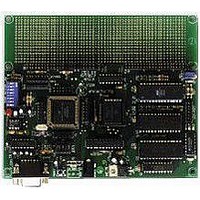CMD-711EX AXIOM, CMD-711EX Datasheet - Page 5

CMD-711EX
Manufacturer Part Number
CMD-711EX
Description
Microprocessor Development Tool
Manufacturer
AXIOM
Datasheet
1.CMD-711EX.pdf
(15 pages)
Specifications of CMD-711EX
Silicon Manufacturer
Freescale
Kit Contents
Board
Silicon Family Name
68HC11E
Silicon Core Number
MC68HC11E9FN, MC68HC11E20FN
Development Tool Type
Hardware - Eval/Demo Board
Lead Free Status / RoHS Status
Contains lead / RoHS non-compliant
For this tutorial we'll use a sample assembly language program in the EXAMPLES sub-directory called HELLO.ASM.
This small program sends a text string to your PC serial port.
You should now have a new file called HELLO.S19 (a Motorola hex object file) in the EXAMPLES directory. The
HELLO program is memory mapped to EXTERNAL RAM, starting at address $2400. Follow these steps to load and
execute the program using the Buffalo Monitor program:
If everything is working properly you should see the message "Hello World" echoed back to your terminal screen and,
since we return at then end of the hello program, a status message and lines containing the internal register status
displayed by the monitor. You are then returned to the monitor prompt.
If you do not get this message try going through this tutorial once more then, if still no go, see the
TROUBLESHOOTING section. If the HELLO.ASM file has been modified you'll may need to re-load it from the disk
or change it back for this to work.
You can modify the hello program to display other strings or do anything you want. The procedures for assembling
your code, uploading it to the board and executing are the same.
The Buffalo monitor has many powerful features such as breakpoints, assembly/disassembly, memory dump and
modify and program trace. Type HELP at the prompt for a listing of commands.
Programming the External EEPROM
When finished with program development you’ll probably want to write your program to EEPROM so that it executes
automatically when you apply power to the board.
1. Use a text editor to modify HELLO.ASM. Change the start of your program, ROMBS, to $E000 which is near the
2. Remove the comment * character before the first line after START. This will initialize the stack pointer which is
3. Add a comment * character before the first RTS instruction at the end of the main loop so that the program will
1. If you haven’t done so already, verify that the development board is connected and operating properly by
2. From the Menu, select Assemble.
3. Change to the Examples directory and double-click the source file HELLO.ASM. This will launch a DOS
4. If any errors are found they are displayed in this window.
1. Make sure all MODE switches are OFF and apply power to the board or press RESET to get a monitor
2. Hit ENTER to get a > prompt then type LOAD T and press ENTER. This will prepare buffalo to receive a
3. Press the Upload button.
4. Select the file named HELLO.S19 in the EXAMPLES sub-directory.
5. The program will be sent to the development board through the serial port. When finished uploading, press
6. Type CALL 2400 and press ENTER.
beginning of the EEPROM in U5.
necessary when running outside of buffalo but should not be done while running under buffalo since buffalo must
handle the stack.
perform an endless loop when finished, instead of returning.
following the steps under GETTING STARTED.
window and execute the assembler to assemble the hello program.
prompt in the terminal window.
program.
the ENTER key. If you are familiar with hex record format, you can see the first S1 record starts at $2400.
This tells the monitor to execute the subroutine at address $2400, which is the start of our test program.
5
















